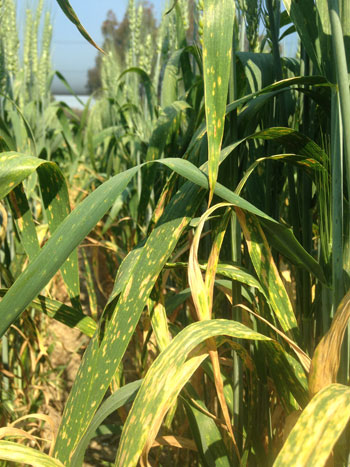Multiple new sources of resistance to yellow spot – also known as tan spot – are making their way into Australian wheat breeding programs.
Research into genetic resistance is being bolstered to suppress yellow spot – the second-most-damaging wheat disease after stripe rust. The disease costs growers up to $30 a hectare in lost production and control costs in hard-hit areas.
Controlling yellow spot with fungicides is problematic because disease inoculum remains on stubble throughout the year and leaf infections in the lower canopy can reinfect upper leaves later in the season.
Genetic resistance plays an important role in curbing the disease in-crop. GRDC investment in two national projects led by the Western Australian Department of Primary Industries and Regional Development (DPIRD) has identified genetic resources for resistance breeding. It has also gleaned valuable information about the likely yield losses associated with a variety’s disease resistance rating.
Resistance genes
Genetic analysis undertaken over 10 years reviewed existing breeding material to identify 20 new yellow spot resistant genes. Previously the only gene known to Australian breeding programs was tsn1. DPIRD’s partners included Agriculture Victoria, the Queensland Department of Agriculture and Fisheries (DAF) and the universities of Adelaide and Southern Queensland.
Using these resistance genes, the research team has developed 51 new wheat lines that are adapted to the western and southern production regions and have a combination of three, four or six stacked genes. These lines show higher levels of resistance due to additive gene effects and have been provided to breeding companies for resistance breeding.
For the northern region, 20 lines with three stacked genes have been developed and are being evaluated.
Like all pathogens, yellow spot has the capacity to mutate and overcome a plant’s genetic resistance. While this has not yet happened with yellow spot in Australia, stacking several resistance genes in one breeding line makes it more difficult for the pathogen to break down the wheat plant’s defences.
A spin-off from this research has been the identification of novel sources of genes with multiple disease resistance. Screening of 2445 lines from around the world found seven lines with moderate to high levels of resistance to yellow spot, Nodorum blotch and powdery mildew. These lines are now being developed for future research and to identify potential breeding material.
Understanding yield loss
A five-year study of wheat yield loss provided the first set of definitive results demonstrating the influence of variety partial resistance, epidemic intensity and environment responses to yellow spot.
Partial resistance is conferred by several minor genes contributing small but additive effects, which means that resistance is incomplete but more durable than the complete resistance conferred by a single major gene. Project partners were DAF, Agriculture Victoria and the NSW Department of Primary Industries.

The susceptible variety Correll (PBR) showing high levels of yellow spot infection at the adult plant stage in the field. Photo: DPIRD
Although variety resistance ratings for yellow spot provide critical information to help growers manage disease, the potential yield loss associated with each resistance rating was not known.
Seven field trials at South Perth in WA, Hermitage in Queensland and Horsham in Victoria between 2015 and 2017 examined the impact of five disease levels on the yields of five or six wheat varieties in each resistance category. Varieties were selected on the basis that they were adapted to the particular region, had similar maturities and were resistant to other diseases that were potential contaminants.
The existing partial resistance was effective in reducing losses from yellow spot in the current commercial wheat varieties by 29 to 64 per cent compared to the losses observed in susceptible varieties.
Quantifying the potential yield loss for each resistance rating for yellow spot enables growers and advisers to make informed decisions about variety and paddock selection.
More information: Dr Manisha Shankar, 08 9368 3533, manisha.shankar@dpird.wa.gov.au

























































